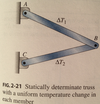Mechanics; Chapter 2 Flashcards
(45 cards)
Structural Components subjected to tension or compression are know as ____ _____ members.
axially loaded

When determining the changes in lengths of axially loaded members, it is convenient to begin with a ______ ______, since the overall stretching or shortening is analogous to the behavior of a bar in tension or compression.
coil spring

The natural length is also called the ____ _____ (3 different names).
unstressed length
relaxed length
free length
When applying a tensile load to a spring, the spring lengthens by an amount _____ and its final length becomes ______ + ______.
δ
L + δ
L= original length)
δ= (Greek Letter Delta)= elongation or uniaxial deflection;

Define Stiffness for a Spring Provide Equation
Defined as the force required to produce a unit elongation in a linear elastic member
k = P/δ
k=stiffness
p= axial force
δ=elongation

Define Flexibility for a Spring Provide Equation
Defined as elongation produced by a load unit value.
f = δ/P
f=flexibility
p=axial force
δ=elongation (Greek Letter Delta)

Stiffness and flexibility of a spring are ______ of each other.
reciprocals
k=1/f
f=1/k
k= Stiffness
f= flexibility

Flexibility of a spring can easily be determined by measuring the _____ produced by a know load.
elongation (δ)
When a prismatic bar of linear elastic material is loaded ONLY at the ends, we can obtain its length from the equation ______.
δ=PL/AE
δ= Elongation (Greek Letter Delta)
P= Axial force
E= Modulus of Elasticity
L= Length
A= Cross Sectional Area

Explain how the equation for Uniaxial Deflection is derived
For a simple homogenous bar with a constant cross section and a constant applied load, the total deflection of the bar can be determined in terms of P, L, A, and E.
Starting with the one dimensional Hooke’s Law, σ = Eε and substituting P/A for stress and δ/L for strain gives, P/A = E (δ/L) This can be rearranged to give, δ=PL/AE

The product AE is knows as the ____ ____ of the bar.
axial rigidity
If a material is _____ _____, the load and elongation will be proportional.
linear elastic
Uniaxial Deflection (Constant Load, Area and Stiffness);
Provide Elongation Equation for series of bars and explain
If there are a series of bars, then the deflection of each section can be determined and then all deflections summed.
This can be written in equation form as δ total=Σ PiLi/AiEi i
Total Deformation= δ = PL1/A1E1 + PL2/A2E2 + PL3/A3E3

The stiffness (k) and flexibility (f) of a _____ ____ are defined in the same way for a spring. Provide equations
prismatic bar
k = AE/L
f = L/AE
k=stiffness
f=flexibility

A cable is considered an _____ _____ member because it is subjected only to tensile forces
axially loaded
Cables are also known as ______ _____.
wire rope
Cross sectional area of a cable is equal to the cross sectional area of the individual wires, called the ______ ______.
effective area
Under the same tensile load, the elongation of a cable is greater then the elongation of a solid bar of the same material & cross sectional area, because the wire cable _____ ____.
tightens up
The modulus of elasticity of a cable is called the ______ _____, and its less then the modulus of the material of which its made.
effective modulus
The effective modulus of steel cables is about ____ksi, whereas the steel itself has a modulus of about _____ksi.
Wire Cable E= 20,000 ksi
Steel E= 30,000 ksi
When determining the elongation of a cable, the ____ ____ should be used for E, and the ____ ____ should be used for A.
Effective modulus
Effective Area
Supposed for instance that a prismatic bar is loaded by 1 or more axial loads acting at intermediate points along the axis, we can determine the change in length by separating the bar into segments and using this equation_____.
δ total = Σ NiLi/AiEi
Ni is the internal axial force in the segment i.
When solving for the elongation for a prismatic bar that is loaded by 1 or more axial loads acting along the axis, never cut at the _____, only cut at the ____ ______.
Joint
Cross Section
In a statically determinate structure, reactions & internal forces can be determined by a _____-______ _______ & ______ __ ________.
free-body diagram
&
equation of equilibrium











